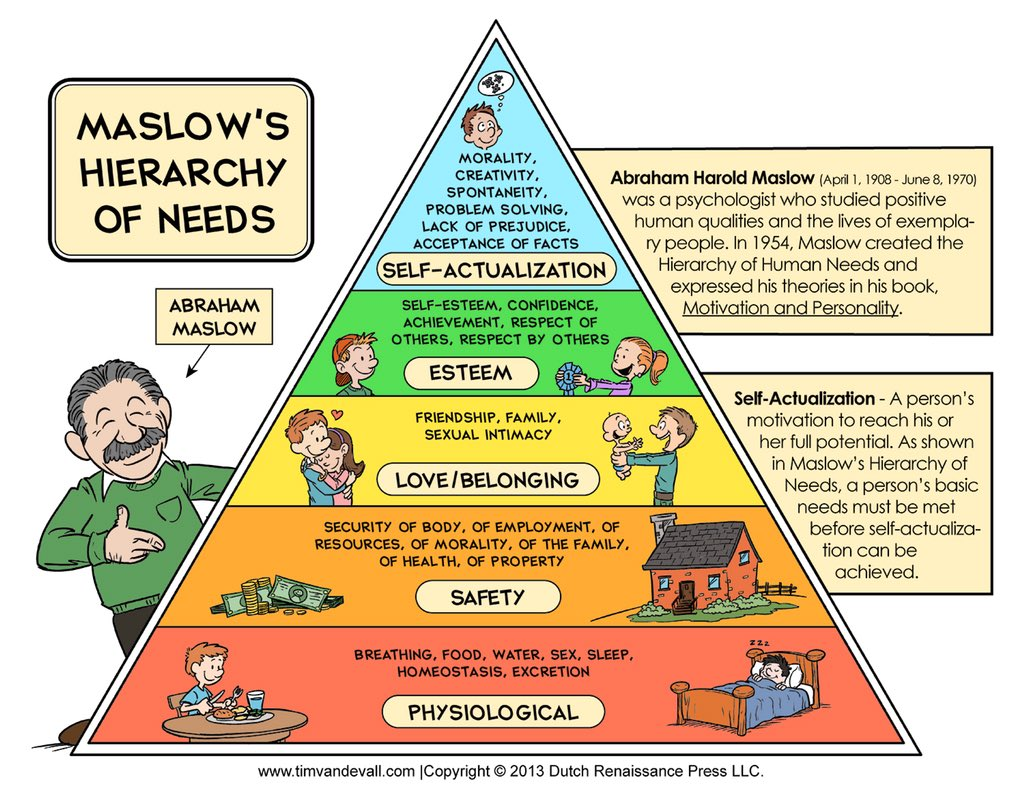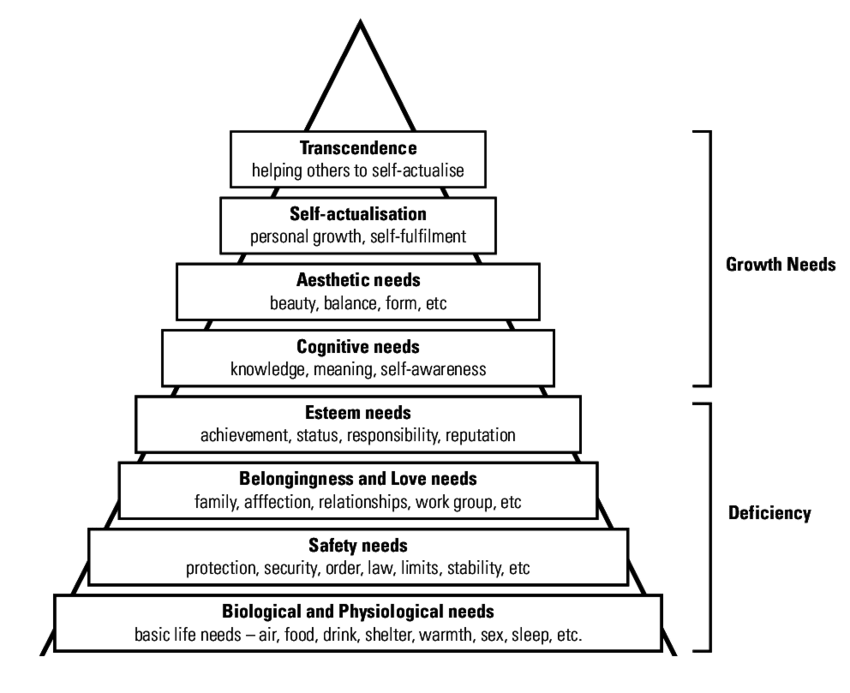Unit 4 - Motivation and Wellbeing (psych)
1/38
There's no tags or description
Looks like no tags are added yet.
Name | Mastery | Learn | Test | Matching | Spaced |
|---|
No study sessions yet.
39 Terms
Motivation
The conscious or unconscious drive leading the behaviours that individuals initiate, direct and maintain
*motives influence behaviour
Motives
The desires behind goal directed behaviour
4 sources/motives of motivation (incl. definition)
Physiological: The needs for survival that motivate most human behaviour e.g. sleep, toilet, drink, hunger, etc
Cognitions: Motivation is derived from intellectual challenges due to the intrinsic motivation that they produce. This drive is to satisfy curiosity and explore personal interests e.g. values, goals, expectations
Emotional: Motivation is derived from trying to avoid pain and seeking happiness e.g. avoid fear, anger, stress or strive for happiness and joy
Social: Motivation is derived from the drive to form connections and relationships with people around us e.g. peer pressure, conforming and seeking approval
3 types of motivation - Self Determination Theory, Deci and Ryan (1985) (incl. defintions)
Amotivation: The lack of intrinsic or extrinsic motivation
Increases when the environment disables behaviour from being performed
Extrinsic motivation: Motivation stems from the desire for external rewards
e.g. respect, money, awards
This motivation is a means to an end
Intrinsic motivation: Motivation stems from an inner desire for self actualisation (full potential) arising from achieving a specific goal
e.g. self gratification
this motivation is an end in itself
3 psychological needs for motivation - SDT Deci and Ryan (1985) (incl. defintions)
Autonomy: The need for people to feel in control of their own actions.
Improves wellbeing + increases motivation
Competency: The need to feel capable of mastering new skills + experiencing a sense of achievement
Increases likelihood of experiencing satisfaction from overcoming obstacles
Relatedness: The longing to form social connections + be part of positive relationships
Improves wellbeing
Strengths and Limitations of Self Determination Theory (Deci and Ryan, 1985)
Strengths
Applicable across cultures/contexts as 3 needs are universal AND intrinsic motivation supports people doing things because they enjoy it rather than solely for reward
Limitations:
Strong emphasis on autonomy may minimise influence of external rewards on motivation AND theory’s complex components may limit ability to comprehend/apply
Application of Self Determination Theory to real world (Deci and Ryan, 1985)
It is desirable to teachers, employers, managers to increase the 3 psychological needs as it improves self determination
This leads to intrinsic motivation which promotes positive wellbeing
Levels of Motivation - Maslow (1954)
Maslow (1954) created a hierarchy of needs based on the idea that everyone should reach self actualisation
Order of needs may vary amongst individuals and people can be motivated by more than one need simultaneously
There is a continual up and down movement as partially/fully satisfied needs may become threatened and require attention
Self actualisation (Maslow, 1954)
The ultimate state of being that everyone is trying to attain.
Involves reaching ones full potential and continually seeking growth and knowledge
2 types of motivation and needs - Maslow (1954)
Deficiency needs: basic needs people are motivated to fulfil due to their absence
Important for survival
Motivation decreases as each need is met
Growth needs: needs that once met, act as the motivation to continue fulfilling them
Develops unique personality + leads to happiness
Motivation increases as need is met
First hierarchy of needs (Maslow, 1954)
Level 1: physiological needs
Level 2: safety needs
Level 3: love and belongingness
Level 4: esteem
Level 5: self actualisation
*don’t say pyramid in exam

Hierarchy of needs (Maslow, 1970)
In 1970, Maslow produced a revised hierarchy of needs after additional reflection and research.
Deficiency needs:
Physiological needs
Safety needs
Love and Belongingness
Esteem needs
Growth needs:
Cognitive needs
Aesthetic needs
Self actualisation
Transcendence needs
Physiological needs (Hierarchy of Needs - Maslow, 1970)
Basic biological requirements that provide energy, physical contentment and health
→ e.g. food, water, shelter, toilet, etc
Safety needs (Hierarchy of Needs - Maslow, 1970)
Involves both physical and emotional safety. A lack of this causes anxiety and lack of confidence in the environment.
→ e.g. stability, order, free from threat
Love and belongingness (Hierarchy of Needs - Maslow, 1970)
Involves both receiving love and giving love. A lack of this can result in isolation and loneliness
→ e.g. worthy of love, affection, etc
Esteem needs (Hierarchy of Needs - Maslow, 1970)
Involves two components…
Self esteem: desire for achievement, confidence and freedom
Respect from others: recognition, attention and appreciation from others
Cognitive needs (Hierarchy of Needs - Maslow, 1970)
Involves gaining knowledge and understanding through senses, personal experiences and mental activity
Curiosity to understand
Philosophy and theology
Aesthetic needs (Hierarchy of Needs - Maslow, 1970)
The appreciation for anything beautiful, contributing to a positive wellbeing. A lack of this can cause a sense of discomfort.
Self actualisation (Hierarchy of Needs - Maslow, 1970)
The ultimate state of being that everyone is trying to attain.
Involves reaching ones full potential and continually seeking growth and knowledge
Increases as people are autonomous
Peaks and troughs are normal here
Restlessness and discontentment are barriers to reaching self actualisation
Transcendence needs (Hierarchy of Needs - Maslow, 1970)
Going beyond the limits of human experience. The deeper meaning found is then used to help humanity rather than focusing on the self.
Pyramid of the hierarchy of needs (Maslow, 1970

Strengths and limitations of Hierarchy of Needs (Maslow, 1970)
Strengths:
The theory focused on healthy human psychological development, uncommon at the time
Theory was supported by a meta analysis conducted by Alexander and colleagues (1991) → results of 42 studies showing transcendental meditation to be progress toward self actualisation
Limitations
Sample = small and purposeful, selected by Maslow
Hierarchical categorisation of needs oversimplifies complex human behaviour and life obstacles
*pyramid shape not created by Maslow
Application of Hierarchy of Needs to real world (Maslow, 1970)
Maslow’s theory provides the framework to educational programs around the world
Physiological needs are required before other needs can be met
Wellbeing
Feeling happy and content, in a positive state in one’s life
Subjective wellbeing - Diener, 1984
The mixture of positive and negative measures + overall emotional and cognitive assessment of life that is personal to everyone
→ It is based on personal experiences and therefore is ‘subjective’ for each person
3 main components that make up subjective wellbeing - Diener (1984)
Life satisfaction
Affective balance (positive affect (2) and negative affect (3)
→ Life satisfaction + Affective balance = Subjective wellbeing
Life satisfaction - 3 main components that make up subjective wellbeing (Diener, 1984)
The overall assessment a person makes of their own life and their own life experiences
These global judgements are the ‘cognitive’ measures of wellbeing
Influenced by feeling an overall positive affect of mood, usually influenced by those closest to you
Affective balance - 3 main components that make up subjective wellbeing (Diener, 1984)
Comprises of all moods, emotions and feelings that an individual experiences.
The moods and emotions make up the ‘emotional’ measure of wellbeing
Positive affect = pleasant emotions
Negative affect = unpleasant emotions
Both affects are experienced, with people attempting to enhance their lives by reducing negative affect and increasing positive affect
A global judgement of happiness is continually assessed by people comparing their negative affect with their positive affect
Strengths and limitations of Subjective wellbeing (Diener, 1984)
Strengths:
Cultural universality: the theory can be applied across cultures and contexts
Theory is comprehensive and holistic
Limitations:
External factors are not considered e.g. finances, work conditions, relationships and cultural influences
Self report: relies on self reporting = subjective measures = can produce bias when participants give answers in order to be socially desirable
Applications of Subjective wellbeing to real world (Diener, 1984)
The effectiveness of public health initiatives and policies are positively influenced by the knowledge of the theory
*includes longitudinal study
Psychological wellbeing scale (PWB) - Ryff, 1989
Designed PWB based off her theory of psychological wellbeing
Higher scores on each scale indicate higher wellbeing
6 factors:
Autonomy
Environmental mastery
Personal growth
Positive relations with others
Purpose in lie
Self acceptance
Autonomy (PWB - Ryff, 1989)
Refers to individuals seeking evaluation from within themselves, using personal standards to make their own decisions with free will
HIGH AND LOW Dimensions:
Independent
Not pressured to conform to social norms
Makes decisions based on self accepted moral principles
Environmental mastery (PWB - Ryff, 1989)
Refers to manipulating the environment to best suit personal needs and feeling able to influence others
HIGH AND LOW Dimensions:
Feels confident in manipulating their environment
Manages complicated tasks
Makes the most of situations they find themselves in
Personal growth (PWB - Ryff, 1989)
Refers to utilising past and present experiences to continually develop as a person and experience new things
HIGH AND WEAK Dimensions:
Has a sense of continual development + self-improvement
Attempts to better themselves by welcoming and reflecting on new experiences
Positive relations with others (PWB - Ryff, 1989)
Refers to individuals who self-actualise finding importance in forming genuine empathetic relationships with others and guiding the younger generations
STRONG AND WEAK Dimensions:
Understands relationships involve compromise
Is empathetic, affectionate and caring toward others
Able to form trusting human relationships
Purpose in life (PWB - Ryff, 1989)
Refers to meaning in life evolving over time, requiring individuals to continually re-evaluate its intentionality and direction
STRONG AND WEAK Dimensions:
Believes past and present has purpose
Sets life goals and has sense of direction
Self acceptance (PWB - Ryff, 1989)
Refers to an individual's acknowledgement of their personal strengths, weaknesses, past decisions and behaviours.
HIGH AND LOW Dimensions:
Accepting of all their characteristics
Has high self esteem
Has positive view on life they have lived
Strengths and limitations of Personal Wellbeing Scale (Ryff, 1989)
Strengths:
Model encompasses multiple dimensions unlike other wellbeing models
PWB survey created by Ryff allowed for empirical evidence to be collected = high reliability and validity
Limitations:
Additional factors that effect wellbeing are not considered e.g. economic and social factors
Negative affect not accounted for e.g. adversity, hardship
Application of Personal Wellbeing Scale to real world (Ryff, 1989)
Used to find that there is a relationship between optimal sleep duration and psychological wellbeing